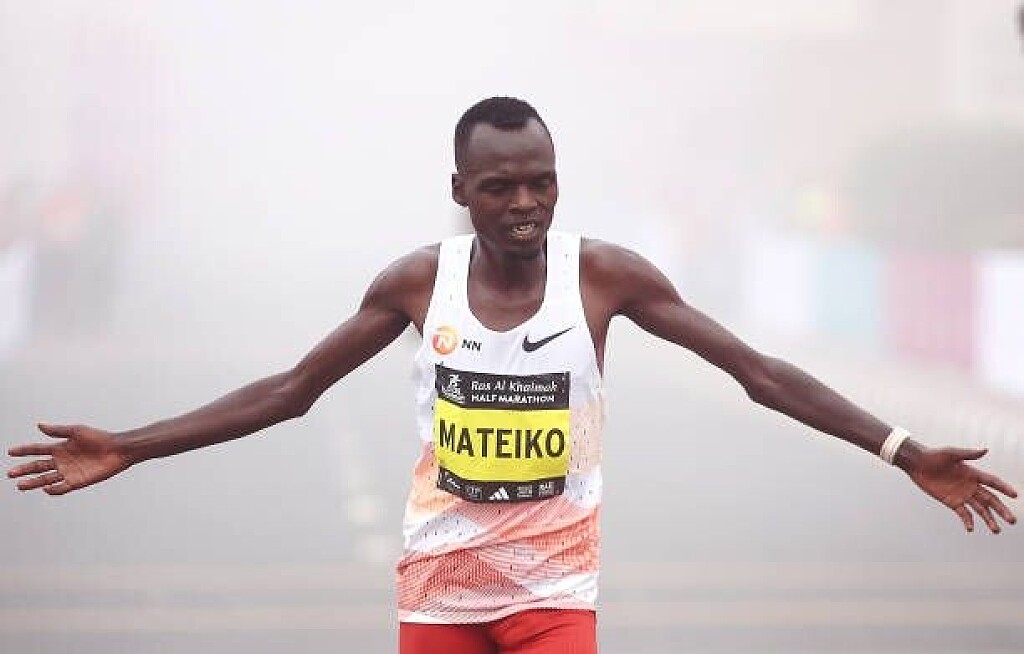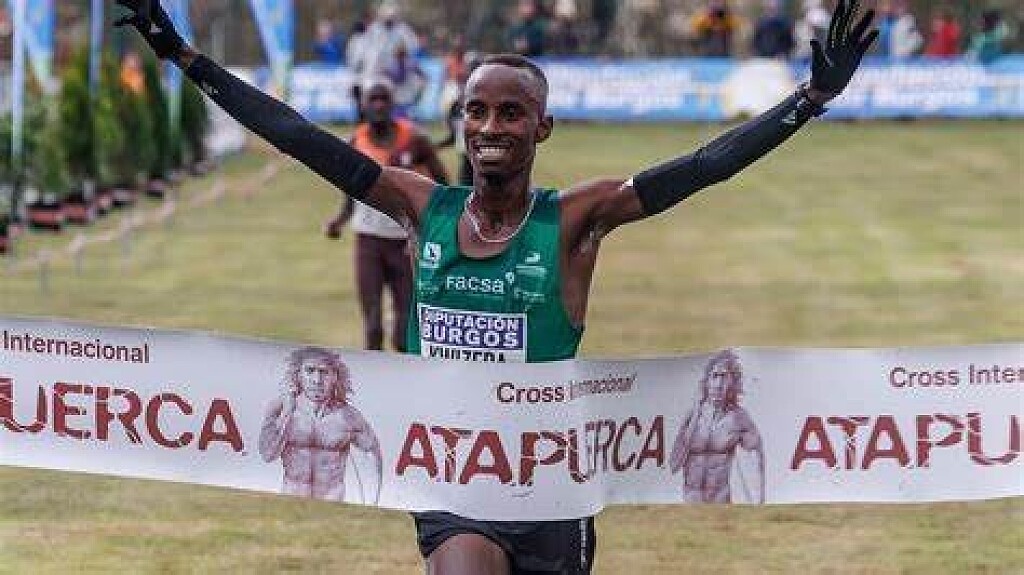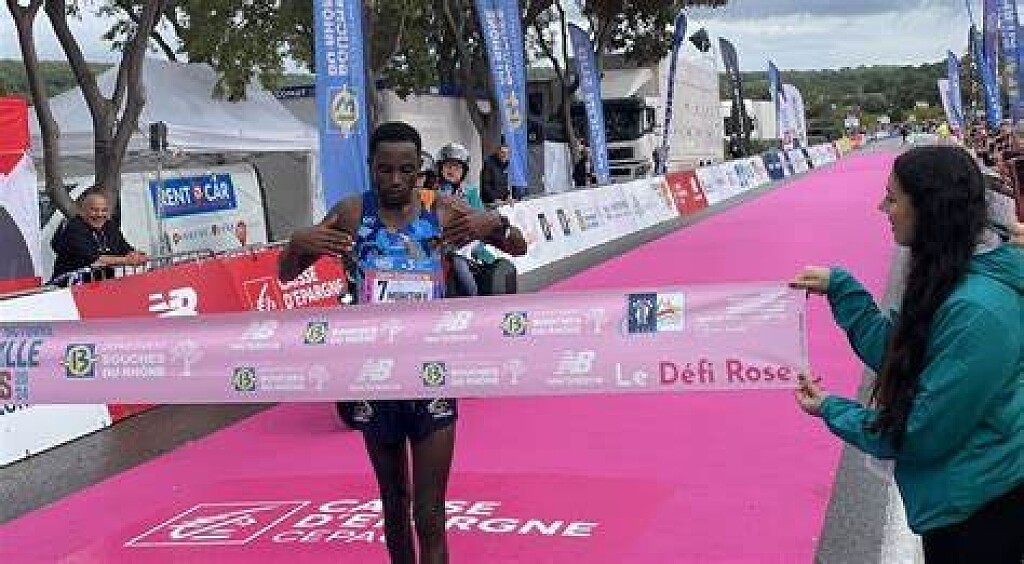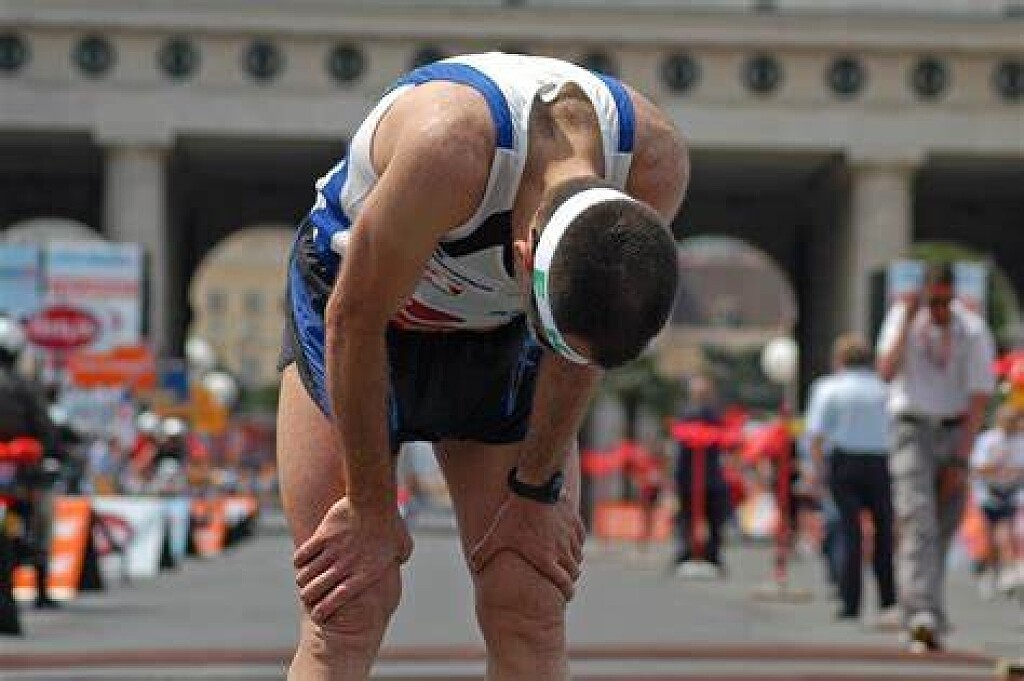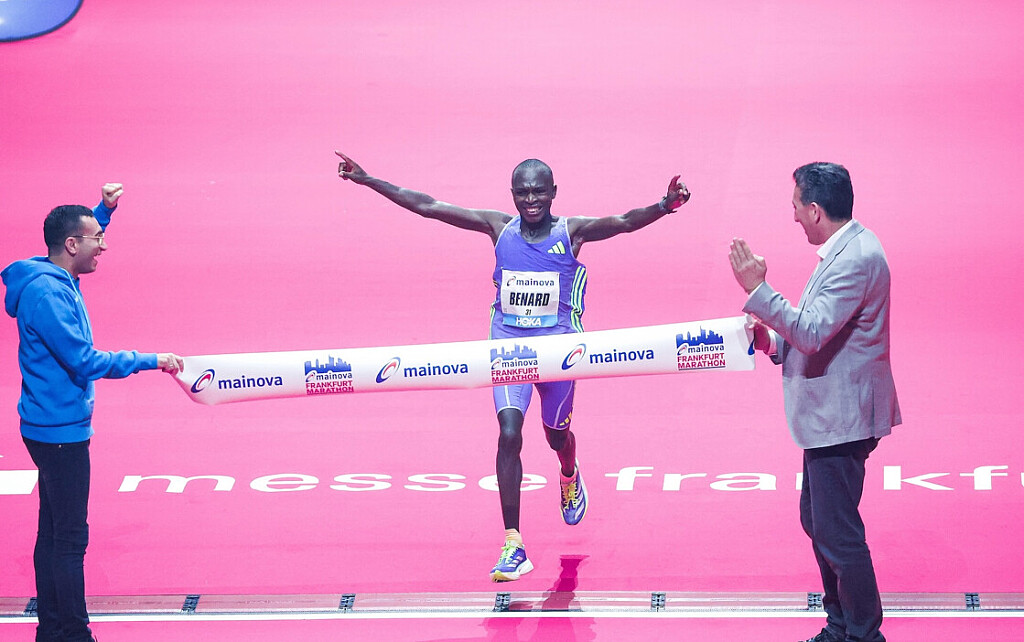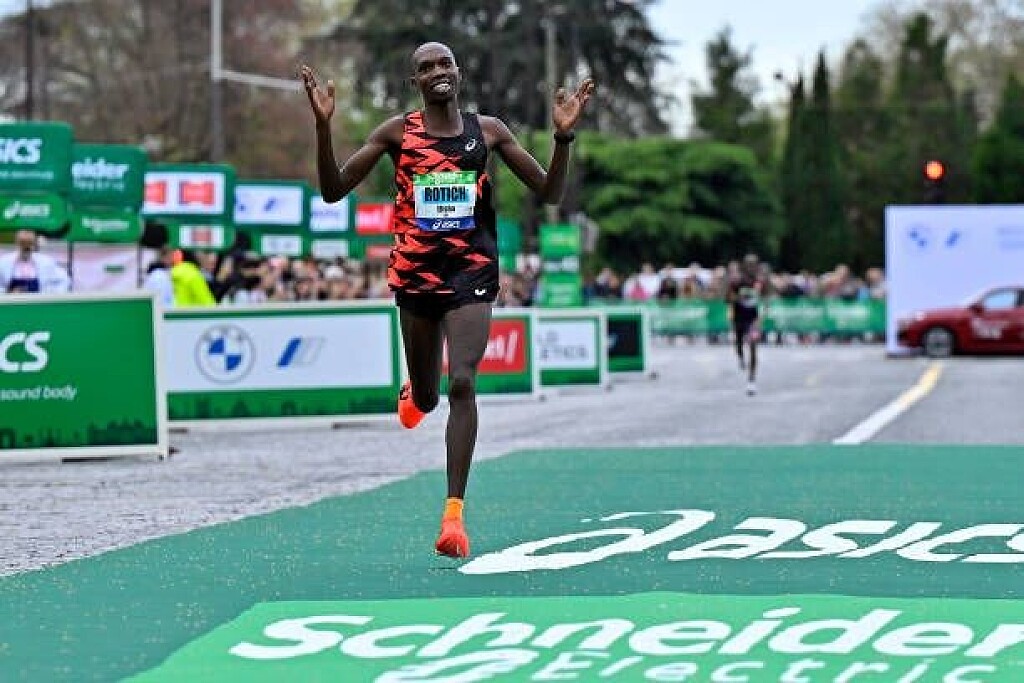Running News Daily
Top Ten Stories of the Week
11/2/2024
These are the top ten stories based on views over the last week.
The Valencia Half Marathon, as star-studded as always
Once upon a time there was an athlete who didn’t know what it was like to take over an hour to run a half marathon, his legs were simply faster than that; he has tried five times, but his worst time, if that’s what you can call it, is 59:25. Three of those occasions have been in Valencia, where he won in 2019 and where he took second place in both 2022 and last year, when he clocked a personal best of 57:41, just 10 seconds off the world record and the third fastest time in history. Yomif Kejelcha arrives in Valencia hungry for glory, after an Olympic year in which he has performed at the highest level, with spectacular times and personal bests over 5000m (12:38.95) and 10,000m (26:31.01), but without the cherry on the cake of Olympic glory, having to settle for sixth place in the 25 laps of the track in Paris, an impressive achievement for 99% of athletes, a disappointment for him, who has hardly amassed any major medals.
It is doubtful that the Ethiopian team will be unable to secure victory considering that Selemon Barega, Olympic 10,000m champion in Tokyo, will also be in action, as he has had a similar season to Kejelcha in 2024, coming in just after him in Paris. Less experienced than his compatriot, Barega faces his third adventure over 21,097 m with the confidence of having run 57:50 here just a year ago in last year’s race, a performance that puts him sixth fastest of all time. It will surely depend on the collaboration between these two Ethiopian stars, once the pacers finish their work, as to how close to Kiplimo’s 57:31 they can fly through the crowded Valencian streets. The athletes in charge of pushing the tempo from the start will be the young Ethiopian Kekeba Bejiga, who will have to set a pace of 2:44/km and the Kenyan Mathew Kiplimo Langat, who will try to stay with the pace until the tenth kilometre to reach it ideally between 27:15 and 27:20. From then on, the stars will vie with each other for victory and the big question is whether they will form an alliance to beat the clock or whether each will keep an eye on the other in pursuit of victory.
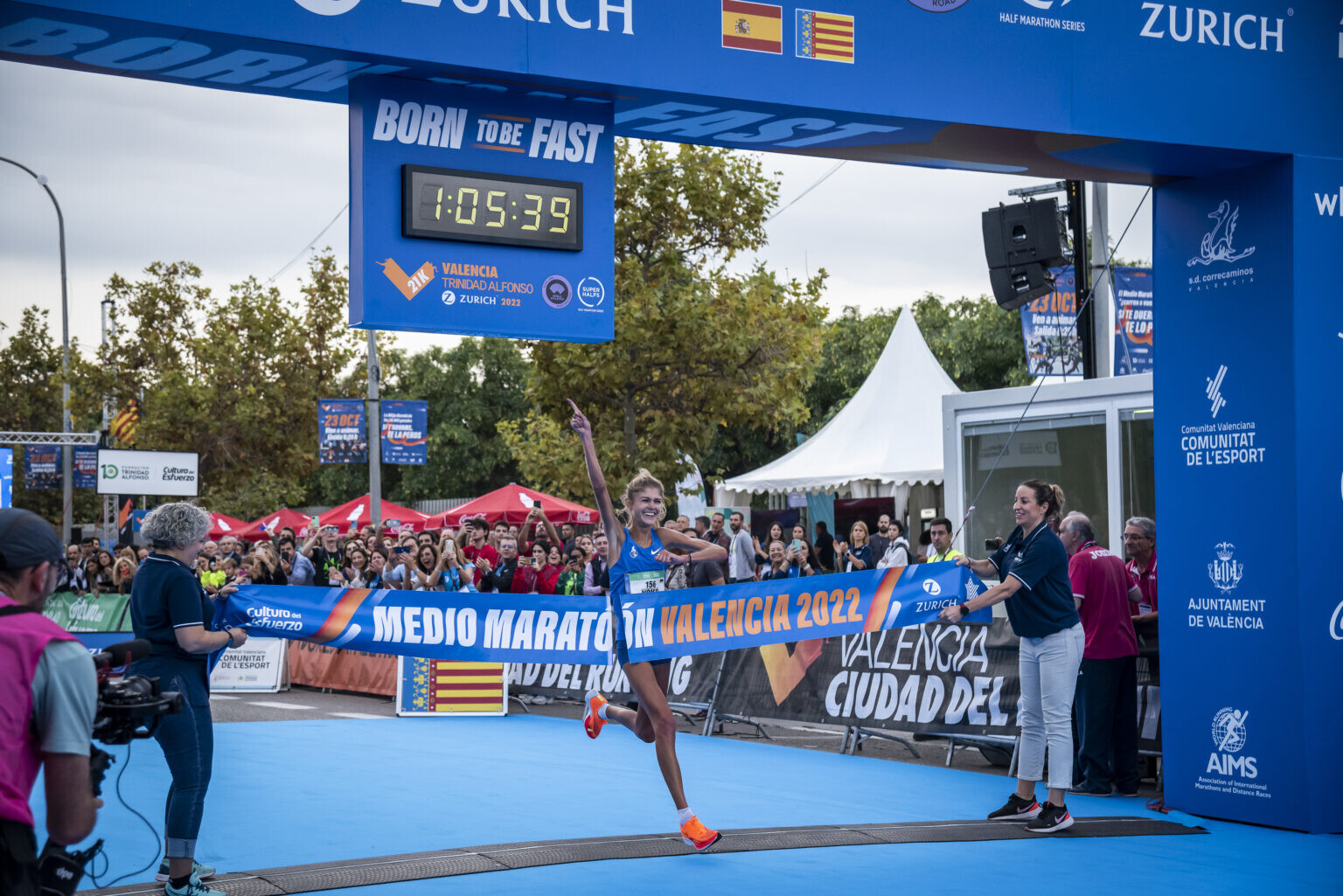
The Kenyan squad will do everything they can to ensure that last year’s victory by Kibiwott Kandie, the man who broke the world record here, running 57.32 in 2020, will continue this year. Their two best assets should be Daniel Mateiko and Isaia Kipkoech Lasoi; the former has already run nine half marathons and knows the Valencian avenues like the back of his hand, coming third in both 2021 and 2022, with 58:26 as his personal best, which he will have to improve on if he wants to stand up to the Ethiopian duo. Mateiko improved his 10,000m time at the Paris Olympics, although his 26:50.81 was only good enough to place him in eleventh position. Lasoi, who is in great form after finishing third in Copenhagen six weeks ago, with a personal best of 58:10 in his fourth (!!) half of 2024, is sure to be in great shape.
Theory tells us that this quartet should be the ones to take the podium places on 27 October, but the magic of the half marathon, which is never as tight as the 42,195m, often brings wonderful surprises. One of them could well be Thierry Ndikumwenayo, who amazed in the Olympic 10,000m by smashing the Spanish record at this distance with a time of 26:49.49. After the rest required following the Games, Thierry may not have had enough time to realise his unlimited potential at this distance, but his performances over shorter distances give him sufficient room for manoeuvre to break the Spanish record, set just a year ago by Carlos Mayo with 59:39 after the previous record had remained unbroken for 22 years. Thierry will have the 59:13 held by Switzerland’s Julien Wanders as the European record in his sights and perhaps the biggest danger for him will be if he remains caught in no man’s land, as joining the leading group, who will be aiming for a sub-58 finish as always, does not seem the most sensible strategy in this his first foray over the distance. This hypothetical record would serve as a well-deserved tribute to Pepe Ortuño, who will retire as his trainer when Thierry crosses the finish line. Tadese Worku, Gemechu Dida, Edward Cheserek and Bravin Kiprop are all well under the one-hour mark and will be looking for their day of glory in Valencia. Among the Europeans, the Portuguese Samuel Barata (national record last year with 59:40), the Italian runner-up at the Europeans Pietro Riva (59:41) and the British runner Emile Cairess (60:01), fourth at the Paris Olympics in the marathon, will be competing with Ndikumwenayo.
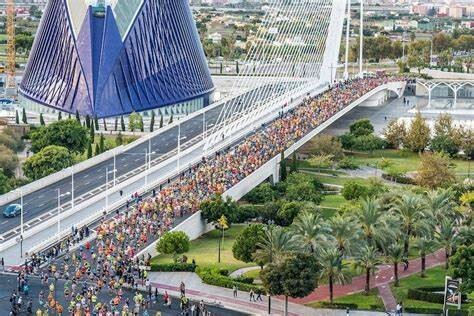
Ngetich wants to make her debut in style
The possibility of a women’s world record will also glimmer over the Valencian asphalt on Sunday, courtesy of Agnes Ngetich, who smashed the 10K world record in Valencia on 13 January with a stratospheric time of 28.46. After that explosion, the Kenyan lost some steam, if we can refer to her 5th place in the World Cross Country Championships in Belgrade as such. During the track season she suffered from physical problems that made her give up the chance to compete in the Kenyan trials in Eugene at the last minute, thus saying goodbye to her Olympic dreams. Since then, her plan has been to make her début in Valencia over 21,097 m and, despite her status as a newcomer, it is not out of the question that she could make a serious attempt at the world record currently held by Ethiopia’s Letesenbet Gidey, who clocked an impressive 1:02:52 in Valencia in 2021. The pacemaking duties will fall to Japhet Kosgei and Vincent Nyageo, who will travel at a tempo of just under 3:00/km, to ensure a challenge to the WR if Ngetich still has some strength in her legs in the final stretch.
Following them will be a large group comprising Tsige Gebreselama, Llilian Rengeruk and Ejgayehu Taye. Gebreselama returns to the scene of her debut two years ago (1:05:46), a time she improved on this February by winning the prestigious Ras Al Khaimah Half in 1:05:14. Although, Ngetich’s biggest threat could be fellow debutant and compatriot Lilian Rengeruk, 5th in the Olympic 10,000m and with a 10K time of 29:32 set in Valencia in January, she is projected to be a strong performer over double the distance. While Taye, also making her debut at this distance, is an accomplished 5K specialist, although she also dipped below 30 minutes (29:50.53) in the 10,000 at the Ethiopian trials in Nerja. The main European hopefuls should be Great Britain’s Samantha Harrison, who improved to 1:07:10 in Valencia last year, and Germany’s Konstanze Klosterhalfen, a brilliant winner on her début two years ago with 1:05:41, although she does not seem to be in her best form at present.
Spain’s record is looking wobbly
If there is a record that has every chance of crumbling on Sunday, it is the Spanish women’s record, not because it is outdated, as Laura Luengo became the record holder just a year ago with her 1:09:41, but because her own form heralds a not inconsiderable improvement on that mark. The On Athletics team athlete will set off at a devilish pace of 3:16/3:17 per kilometre under the guidance of duathlon world champion Javier Martin to seriously threaten the 1:09 barrier. It could well be that she manages to beat that and yet not hold the record as both Irene Sanchez-Escribano and Boulaid Kaoutar are planning to run at the same pace, which could make for an exciting three-way duel. The Toledo athlete shone at the Olympic Games in Paris over her favourite 3,000m steeplechase and is facing a very exciting duel over the distance with confidence; she already ran at a Spanish record pace in the 10K in Laredo (31:35) in March and her good adaptation to asphalt is more than promising. On the other hand, the new Spanish champion Kaoutar (1:10:44 on 6 October in Albacete) already knows what it means to run under the 1:09 mark, as she clocked 1:08:57 in Gijón a year and a half ago when she was still competing under the Moroccan flag. Place your bets.
(10/25/24) Views: 222Emeterio Valiente
Kenyan duo of Daniel Mateiko and Agnes Ngetich lead Kenyan charge at the Valencia half marathon
Daniel Mateiko leads the men's field, while Agnes Jebet Ngetich makes her half marathon debut, promising an exciting race in one of the world’s fastest half marathons.
Kenya’s elite athletes are set to make waves at the highly anticipated Valencia Half Marathon Trinidad Alfonso Zurich on October 27, 2024.
Among them, Daniel Mateiko leads the men's field, while Agnes Jebet Ngetich makes her half marathon debut, promising an exciting race in one of the world’s fastest half marathons.
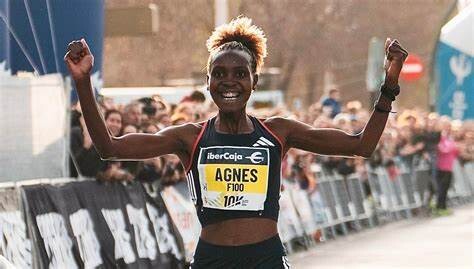
Mateiko, who has clocked an impressive personal best of 58:26, is aiming for a record-breaking time in Valencia.
However, he faces fierce competition from Ethiopia’s Yomif Kejelcha and Selemon Barega, two of the fastest athletes over the half-marathon distance, with personal bests of 57:41 and 57:50 respectively.
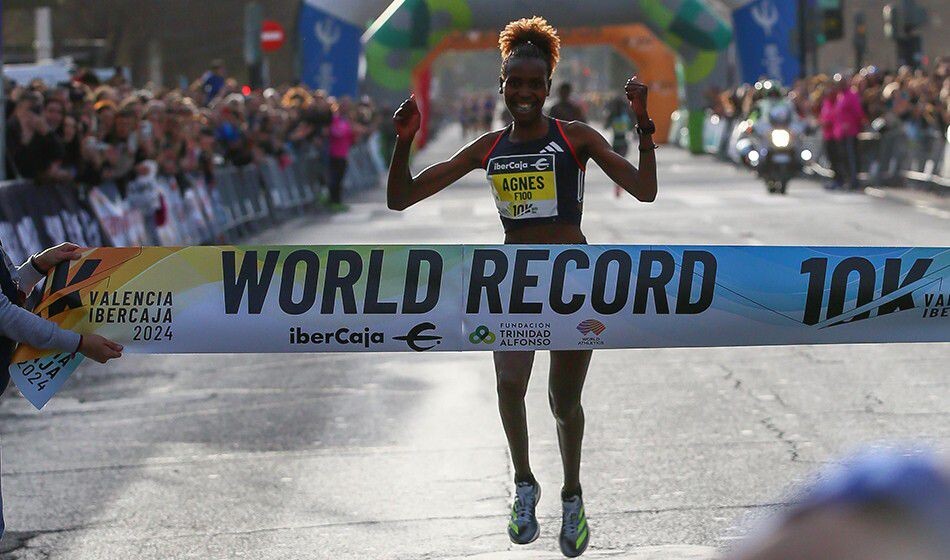
The showdown among these top-tier runners is expected to push the pace and could see new records set.
Joining Mateiko are his compatriots Isaia Kipkoech (58:55), Edward Cheserek (59:11), Bravin Kiprop (59:21), and Weldon Langat (59:22), strengthening Kenya’s presence in the men’s race and adding depth to the country’s bid for top finishes.
In the women’s field, all eyes are on Agnes Jebet Ngetich, who is making her half-marathon debut with high expectations.
Ngetich has already captured the world’s attention this year by breaking the 10K world record in Valencia with a time of 28:46.
This achievement not only demonstrated her speed and resilience but also established her as a formidable contender for her first half marathon.
She will be up against Ethiopia’s Tsigie Gebreselama and fellow Kenyan Lilian Kasait Rengeruk, both of whom bring strength and experience to the competition.
With Valencia's history of producing fast times and world records, the race promises a thrilling spectacle.
The presence of top athletes from Kenya and Ethiopia underscores the high caliber of competition, and the event has the potential to be a milestone in the global running calendar.
(10/26/24) Views: 104Stephen Awino
Jepkemei and Kwizera the winners in Atapuerca
Burundi’s Rodrigue Kwizera and Kazakhstan’s Daisy Jepkemei were the winners at the Cross Internacional de Atapuerca – the second Gold standard meeting in this season's World Athletics Cross Country Tour – on Sunday (27).
With the races held in light rain, Kwizera lived up to expectations to claim his first win here in the men’s race while Jepkemei outsprinted Kenya’s Grace Nawowuna to secure the women’s title.
Right from the start of the women's 8km contest, Jepkemei, a 9:06.66 steeplechaser, took command with only Nawowuna and Burundi’s France Niyomukunzi for company. The latter surprisingly lost ground some seven minutes into the race as Jepkemei averaged a brisk 3:06/km pace. Further back, Spanish duo Carolina Robles and María Forero ran together.
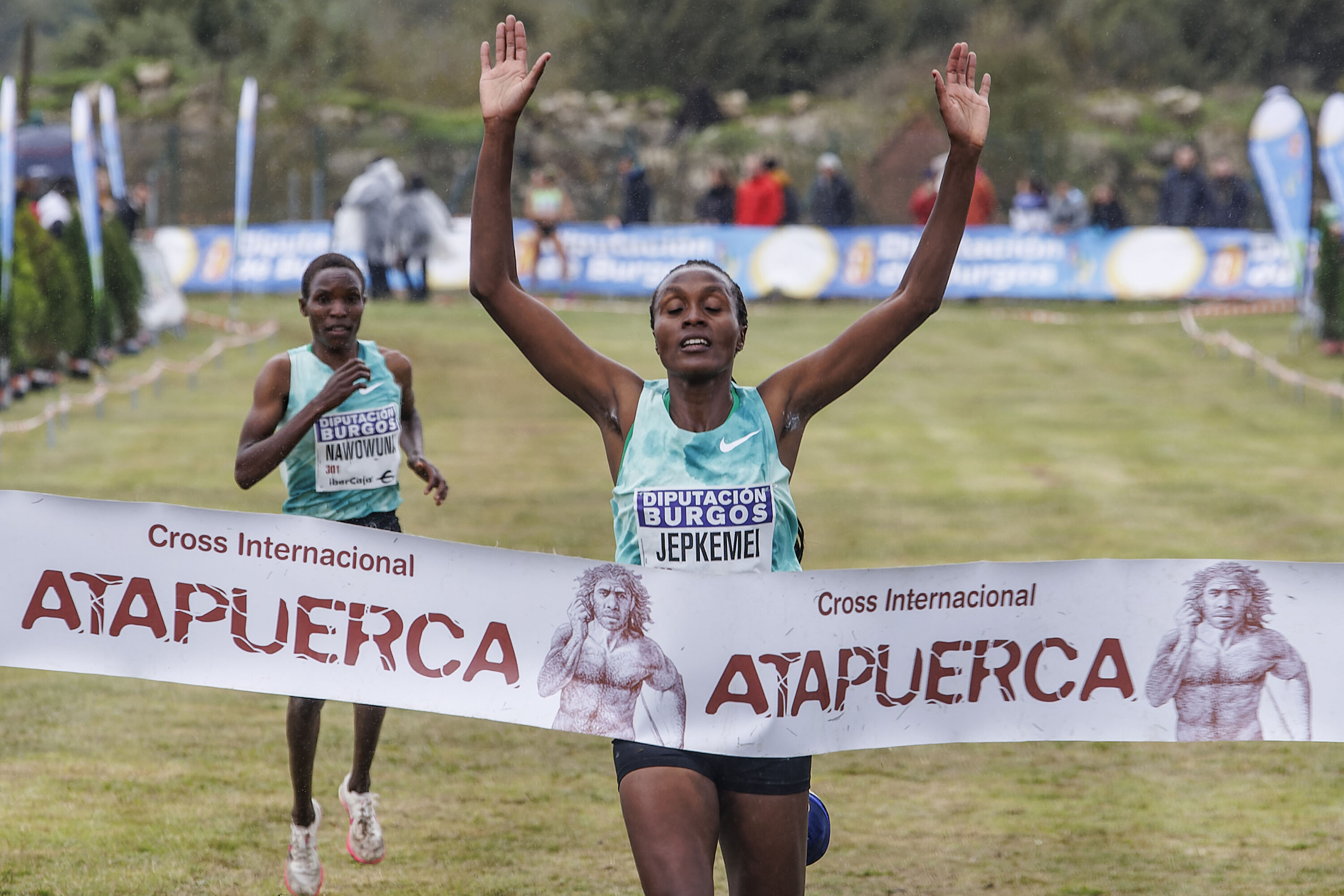
After three kilometres, lead duo Jepkemei and Nawowuna had built a 10-second advantage on the Burundian, herself another 14 seconds clear of the Spanish duo. Portugal’s Mariana Machado, Germany’s Elena Burkard and Spain’s Idaira Prieto were a further eight seconds behind.
Just before the midway point, 2021 Olympic steeplechase finalist Robles broke away from 2022 European U20 cross-country champion Forero, while the lead duo’s advantage over Niyomukunzi had increased to 25 seconds.
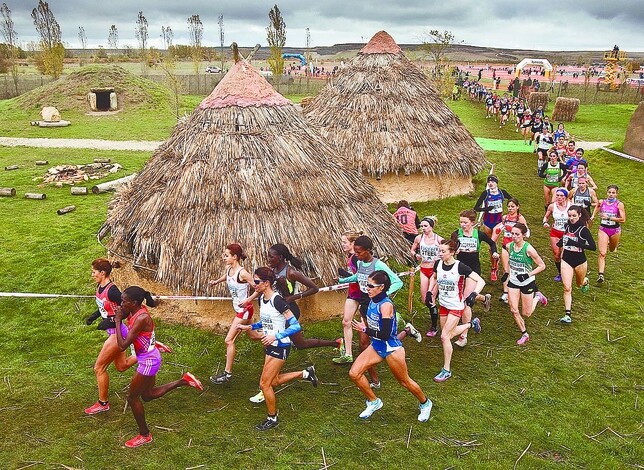
There were few changes on the penultimate 2km circuit. During the final lap Nawowuna attempted to move into the lead but it was short-lived. Then, with about 200 metres remaining, Jepkemei finally broke away from the Kenyan to win in 25:00, finishing two seconds ahead of Naowuna.
Niyomukunzi took third place, more than a minute behind the victor, while Robles finished fourth. There was a photo-finish for fifth place between Burkard and Machado with the German getting the verdict.
Spanish steeplechaser Daniel Arce, boosted by the local crowd, was the early leader from Adel Mechaal in the men’s 9km event. Pre-race favourites Kwizera, 2022 world 5000m bronze medallist Oscar Chelimo and fellow Ugandan Martin Kiprotich initially sat behind the Spanish duo but soon caught up and passed them.
Kiprotich’s third kilometre split of 2:49 proved too much for Mechaal. Chelimo moved into the lead just before the half-way point to help ease the pressure on his compatriot, while a quiet Kwizera remained in third place, looking ominously comfortable.
When the lead pack reached the bell, Kwizera moved to the front for the first time and increased the pace which could only be followed by Chelimo and Kenya’s Mathew Kipsang with Kiprotich losing any chance of a podium place. With just over a kilometre remaining, Chelimo tried to launch an attack but Kwizera soon covered the gap and then unleashed a powerful change of speed to break away from the Ugandan.
Running down the final home straight, 25-year-old Kwizera couldn’t hide his joy as he was about to achieve his first win in Atapuerca, finishing in 25:37, two seconds ahead of Chelimo with Kipsang completing the podium another seven seconds adrift.
“The race wasn’t easy because of the rain and some muddy sections difficult to negotiate,” said Kwizera. “As usual, I preferred to stay in the middle of the group for much of the race before launching my attack far away from home as there always are very fast finishers.”
Leading results
Women (8km)
1 Daisy Jepkemei (KZK) 25:00
2 Grace Nawowuna (KEN) 25:02
3 Francine Niyomukunzi (BDI) 26:18
4 Carolina Robles (ESP) 26:40
5 Elena Burkard (GER) 26:48
6 Mariana Machado (POR) 26:48
7 Águeda Marqués (ESP) 26:50
8 María Forero (ESP) 26:54
Men (9km)
1 Rodrigue Kwizera (BDI) 25:37
2 Oscar Chelimo (UGA) 25:39
3 Mathew Kipsang (KEN) 25:46
4 Egide Ntakarutimana (BDI) 25:48
5 Martin Kiprotich (UGA) 25:50
6 Adel Mechaal (ESP) 26:11
7 Ayele Tadesse (ETH) 26:11
8 Efrem Gidey (IRL) 26:18
(10/28/24) Views: 102World athletics
Marseille-Cassis: Rwanda's Félicien Muhitira wins the race, Martégal's Clémence Calvin wins the women's race
Rwanda's Félicien Muhitira, 29-year-old athlete crossed the finish line after 1:01:42 of effort. Clémence Calvin won the women's race in 1:13:32.
Arriving limping after only an hour of effort (1h01'42"), the Rwandan won the 45th edition of Marseille-Cassis on Sunday morning. After 20km, the athlete kissed his shoes on the finish line to pay tribute to the Burundian Gervais Hakizimana who died in February who had given him his pair. "I was very focused today. It's a good victory," the winner reacted emotionally to France 3.
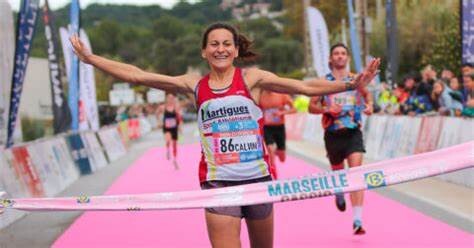
The second in the men's race, the Moroccan Youssef Benhadi had more difficulty when it came to finishing his effort as he was taken care of by the emergency services. The Frenchman Félix Bour completed the podium in the men's race. "I lacked freshness. I did three races in a row this month, I thought it would be enough but the Gineste is not forgiving! The defeat is bitter, I came for the victory but a podium is not to be refused...", he said.
Nicolas Navarro from Aix, a member of the SCO Ste Marguerite, finished at the foot of the podium. "I've already done much better in terms of time, but I still had fun." Clémence Calvin won the women's race in 1:13:32? "I'm happy, I held up well mentally. Since Carro-Carry, I feel like I've had a click. Six years after my first participation, I've added this great international classic to my list of achievements and I'm very happy about it," said the first woman in the general standings.
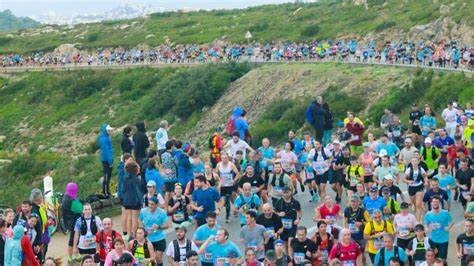
As a reminder, nearly 20,000 riders took the start this Sunday morning of this 20-kilometer race, at 9 a.m., in front of the Velodrome, which will host the long-awaited Clasico this Sunday evening (8:45 p.m.).
(10/28/24) Views: 93T.Le.
When should you not finish a race?
It’s a question many runners have faced mid-race: should I stop? The thought of pulling out can cross any runner’s mind when the day isn’t going as planned, whether you’re leading the pack or you’re dead last. After all, you’ve put in the time and effort to reach the start line, and even if training suggests you’re in great shape, pushing through to the finish can be a challenge. While persevering is often the right choice, there are times when stepping off the course might be the wisest decision. Here’s a look at when you should consider the dreaded DNF.
Injury or pain beyond discomfort
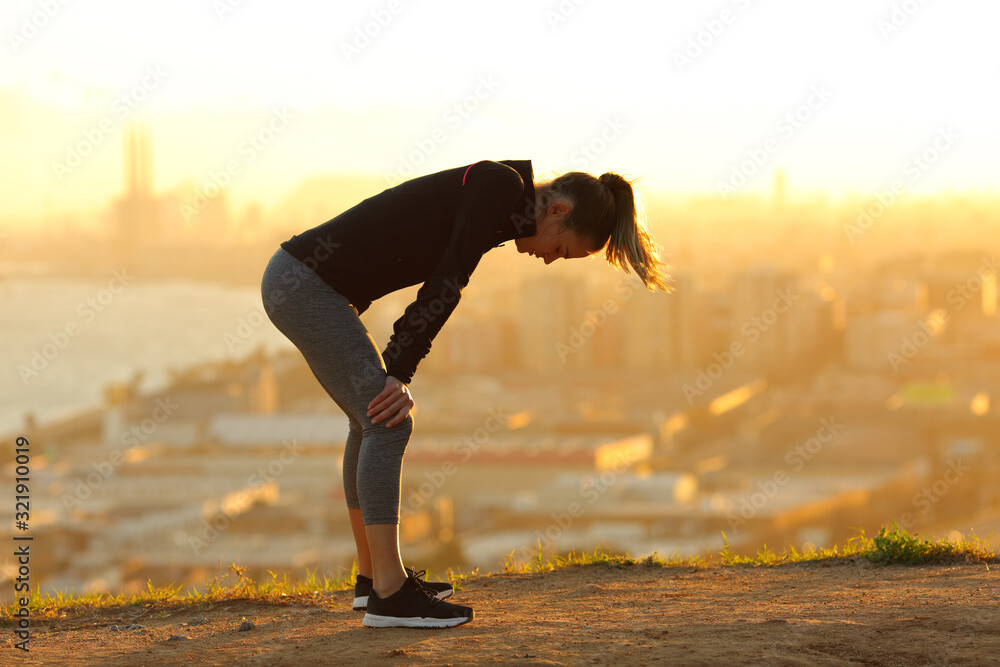
It’s one thing to feel the familiar aches that come with pushing your limits, but it’s another to feel a sharp, shooting pain that signals a potential injury. If you experience pain that worsens with each step, it could be a sign of a stress fracture, muscle tear or joint damage. Ignoring these signs can turn a minor injury into a serious one, potentially keeping you off your feet for the long term.
Common injuries like IT band syndrome or Achilles tendinitis can worsen if you push through them. If the pain alters your gait or you find yourself limping, it’s time to listen to your body and consider calling it a day. It’s better to miss one race than to be sidelined for a whole season.

Dehydration or heat exhaustion
Races that are held in the middle of the summer come with the risk of dehydration or heatstroke. While sweating and feeling thirsty are normal during endurance events, certain symptoms indicate that your body is struggling to keep up. Dizziness, confusion and cramping are all signs of dehydration. In more severe cases, you may experience chills, even in warm weather—a sign of potential heat exhaustion.
If you feel disoriented or experience a sudden drop in energy levels that doesn’t improve after slowing down and hydrating, you should seek medical attention. Continuing in such a state can lead to serious complications or even death. Hydration is critical, but sometimes, even the most prepared runners can find themselves in a situation where stopping is the safest option.
Gastrointestinal distress
GI issues are not uncommon, especially during longer marathons and ultras, where the stress on the body is higher and you must consume nutrition. If you’re dealing with an upset stomach, nausea or diarrhea, you might be able to push through, depending on the severity. However, if the discomfort is unbearable or you’re unable to keep fluids down, it’s wise to pull back and locate a porta-potty to take care of the issue.
(10/26/24) Views: 92
Marley Dickinson
50 Motivational Running Quotes About Racing
Find Inspiration from Running Icons and Legends
Even the most motivated among us occasionally has a challenging time wanting to lace up our shoes and hit the pavement running. Bookmark this page for the next time motivation is waning for you. Read on for inspirational race quotes to pump you up before your next run.
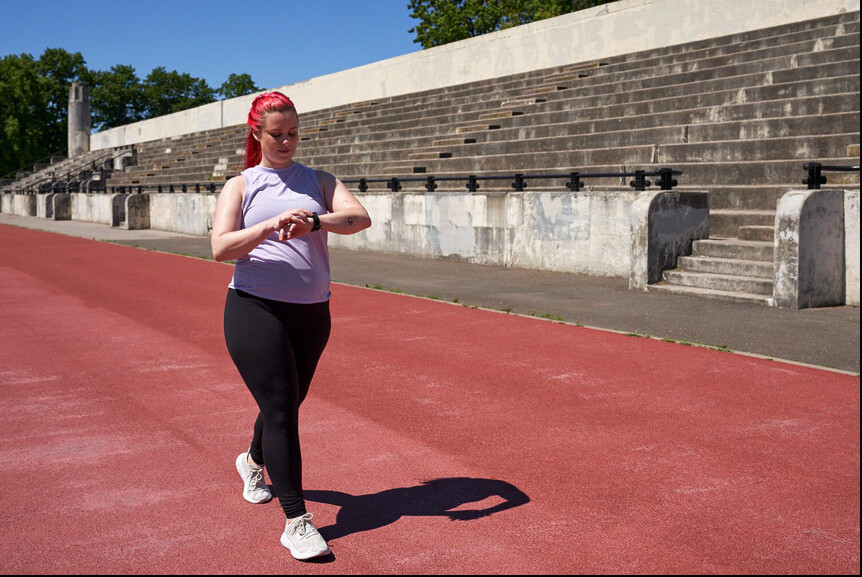
"The miracle isn't that I finished. The miracle is that I had the courage to start." —John Bingham, running speaker and writer
"Fear is gradually replaced by excitement and a simple desire to see what you can do on the day." —Lauren Fleshman, American distance runner
"It doesn't matter whether you come in first, in the middle of the pack, or last. You can say, 'I have finished.' There is a lot of satisfaction in that." —Fred Lebow, co-founder of the New York City Marathon
"When you put yourself on the line in a race and expose yourself to the unknown, you learn things about yourself that are very exciting." —Doris Brown Heritage, women's distance running pioneer
"Good health, peace of mind, being outdoors, camaraderie: those are all wonderful things that come to you when running. But for me, the real pull of running—the proverbial icing on the cake—has always been racing." —Bill Rodgers, winner of four Boston Marathons
"Big occasions and races which have been eagerly anticipated almost to the point of dread, are where great deeds can be accomplished." —Jack Lovelock, environmentalist and futurist
"I also realize that winning doesn't always mean getting first place; it means getting the best out of yourself." —Meb Keflezighi, 2004 Olympic Marathon silver medalist
"Why race? The need to be tested, perhaps; the need to take risks; and the chance to be number one." —George Sheehan, running columnist and writer
RELATED: A Beginner's Guide to Becoming a Runner
"Everyone in life is looking for a certain rush. Racing is where I get mine." —John Trautmann, Olympic runner
"I'm always nervous. If I wasn't nervous, it would be weird. I get the same feeling at all
"My thoughts before a big race are usually pretty simple. I tell myself: 'Get out of the blocks, run your race, stay relaxed. If you run your race, you'll win.'" —Carl Lewis, nine-time Olympic gold champion
RELATED: How to Plan a Running Route Using Map Apps on Your Phone
"I love controlling a race, chewing up an opponent. Let's get down and dirty. Let's fight it out. It's raw, animalistic, with no one to rely on but yourself. There's no better feeling than that." —Adam Goucher, U.S. Nationals 5K race champion
"I'm going to work so that it's a pure guts race at the end, and if it is, I am the only one who can win it." —Steve Prefontaine, legendary American long-distance runner
"Let's just say it and be done with it. Racing hurts. But here's another truth: having put in the effort to prepare for a race and then not giving it your all hurts even more. The first kind of hurt goes away in hours or a day. The second kind of hurt can last a lifetime." —Larry Shapiro, author of Zen and the Art of Running
"Different people have different reasons for racing, but
"Running is in my blood—the adrenaline flows before the races, the love/hate of butterflies in your stomach." —Marcus O'Sullivan, Irish middle-distance runner
"It's just as important to remember that each footstrike carries you forward, not backward. And every time you put on your running shoes you are different in come way than you were the day before. This is all good news." —John Bingham, American marathon runner
"Racing teaches us to challenge ourselves. It teaches us to push beyond where we thought we could go. It helps us to find out what we are made of. This is what we do. This is what it's all about." —PattiSue Plumer, U.S. Olympian
"You didn't beat me. You merely finished in front of me." —Hal Higdon, American writer and runner
"Fast running isn't forced. You have to relax and let the run come out of you." —Desiree Linden
"No marathon gets easier later. The halfway point only marks the end of the beginning." —Joe Henderson, famed running coach
RELATED: Race Day Tips for Running Your First 5K
"No matter how old I get, the race remains one of life's most rewarding experiences." —George Sheehan
"If you feel bad at
"What distinguishes those of us at the starting line from those of us on the couch is that we learn through running to take what the days gives us, what our body will allow us, and what our will can tolerate." —John Bingham, running writer and speaker
"For me, races are the celebration of my training." —Dan Browne, National Champion 5K and 20K runner
"Run when you can, walk if you have to, crawl if you must; just never give up." —Dean Karnazes, ultramarathon runner
"Every race is a question, and I never know until the last yards what the answer will be. That's the lure of racing." —Joe Henderson
"It's amazing how the same pace in practice can feel so much harder than on race day. Stay confident. Trust the process." —Sara Hall, American long-distance runner
"Winning has nothing to do with racing. Most days don't have races anyway. Winning is about struggle and effort and optimism, and never, ever, ever giving up." —Amby Burfoot, American marathon runner
"Your goal is simple: Finish. Experience your first race, don’t race it." —Bob Glover, author of The Runner's Handbook
"Don't dream of winning, train for it!" —Mo Farah, Olympic long
"Nothing, not even pain, lasts forever. If I can just keep putting one foot in front of the other, I will eventually get to the end." —Kim Cowart, runner and journalist
"The real purpose of running isn't to win a race. It's to test the limits of the human heart." —Bill Bowerman, co-founder of Nike
"Our running shoes have magic in them. The power to transform a bad day into a good day; frustration into speed; self-doubt into confidence; chocolate cake into muscle." —Mina Samuels, author of Run Like a Girl
"There is magic in misery. Just ask any runner." —Dean Karnazes
"Run often. Run long. But never outrun your joy of running." —Julie Isphording, American Olympic runner
(10/26/24) Views: 92High-Intensity Intervals vs Low-Intensity Steady State: Which Is Better for Your Run Performance?
Everything to know about high-intensity interval training and low-intensity steady-state cardio—and how they benefit your running performance.
Sure, running is just as easy as putting on the right shoes and heading outside, but once you get into it, you start to see information in the form of acronyms, such as DNF (did not finish), FKT (fastest known time), plus HIIT (high-intensity interval training) and LISS (low-intensity steady-state workouts).
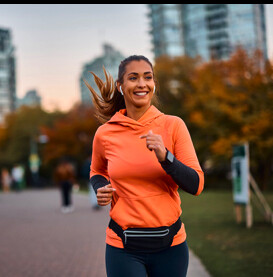
Not only should you understand what both HIIT and LISS mean, they are also two types of workouts every runner should have on their training plan. So, with the help of experts, we explain the benefits of HIIT versus LISS, plus when to use them throughout training to improve performance so you reach your running goals.
HIIT vs. LISS: How They Compare
High-intensity interval training a.k.a. HIIT workouts involve alternating periods of higher-intensity effort and lower-intensity effort or rest.
On the other end of the spectrum, low-intensity steady-state workouts a.k.a. LISS means exercising at a low to moderate effort for a longer period of time.
Both workouts will help you improve as a runner, according to a 2015 study published in the Journal of Sports Science & Medicine. The researchers had 55 untrained college-age people do either HIIT protocols or steady-state training for eight weeks. Both groups saw improvements in their VO2 max and other physical fitness metrics, and there were no significant differences between the groups.
That said, runners will gain slightly different benefits from each type of run, which is why there is room for both types of workouts in every runner’s training plan.
Details on HIIT Workouts, Including Pros and Cons
As mentioned, HIIT workouts include bursts of high-intensity work and then you either pause or do a lower-intensity segment, Milica McDowell, P.T., D.P.T., an exercise physiologist, physical therapist, and vice president of operations at Gait Happens tells Runner’s World. “The gap between the high and the low can vary, and the duration between the high and the low can vary,” she says.
Typically, the high-intensity work intervals should be
Benefits of HIIT Workouts
1. HIIT Challenges You
“HIIT really gives individuals an opportunity to train above a threshold,” Alex Rothstein, C.S.C.S., exercise physiologist and program coordinator of exercise science at the New York Institute of Technology tells Runner’s World.
Exercising outside of your comfort zone means your body keeps adapting to the work, and you grow stronger, faster, and more comfortable with the discomfort over time, he says, which can help you on race day. HIIT workouts help you learn what it feels like to push through really intense bouts of work, which might be what a surge to the finish line feels like.
Pushing yourself outside of your comfort zone also helps you physiologically. McDowell explains that these workouts are based on the concept of “overload.” Essentially, each tough interval challenges your body to work harder so it has to keep adapting to the work, growing stronger in the process.
2. It’s Time Efficient
HIIT runs might only take 20 to 30 minutes, and that’s a plus if that’s all the time you have in the day for exercise, Rothstein says.
Research, including a 2023 meta-analysis in the International Journal of Environmental Research and Public Health, routinely
This is another reason to keep your HIIT runs short.
2. Increased Risk of Injury
You shouldn’t do high-intensity running workouts every day without proper time for rest and recovery. Overdoing it with HIIT can put you at risk for overuse injuries, Rothstein says.
You also need to have some amount of base fitness before you jump in, McDowell says. “If you’re not conditioned, and you decide you’re going to go sprint up a hill several times, that puts your tendons, your muscles, all sorts of structures, at risk,” she explains. So if you’re new to HIIT, make sure to ease into it gradually.
Details on LISS Workouts, Including Pros and Cons
LISS—low-intensity, steady-state workouts—is what you should think of when you see the “fat-burning zone” label on your favorite treadmill, per the National Academy of Sports Medicine (NASM). It’s also sometimes referred to as LSD or long slow distance training, McDowell says.
This is a slow-and-steady pace you could maintain for quite some time and is also sometimes compared to zone 2 training by those who run by heart rate, Rothstein says.
These workouts should get you to somewhere between 50
3. It Feels Good
Lots of runners lace up simply for the mental health benefits. It’s not uncommon for LISS running to clear your mind, help you feel more grounded or centered, or even bring on the runner’s high—and those are all valid reasons to keep doing it, Rothstein says.
In fact, in the Journal of Sports Science & Medicine study mentioned above, exercisers reported an eight-week HIIT routine to be less enjoyable than eight weeks of steady-state training.
4. It trains your gut
New runners or runners tackling a new distance are no strangers to the mid-run porta potty break to deal with cramps, diarrhea, and even vomiting. “This sounds funny, but you’ve got to train your guts to jiggle,” McDowell says. LISS workouts help get your insides used to all the jostling, she says, so you’re less likely to experience unpleasant GI symptoms when it really matters.
Drawbacks of LISS Workouts
1. It’s Easier to Plateau
Longer, slower training runs don’t push you outside of your comfort zone, Rothstein says. “After a while, it ends up not being enough stimulus to keep promoting change,” he says. That means you might not notice as much progress
It’s likely that if you follow a training plan, you will see both types of run on your schedule, but if you create your own plan, remember that the best running workout for you is the one you’ll actually stick to, Rothstein says.
(10/27/24) Views: 85Hawi Feysa smashes course record with 2:17:25 in Frankfurt
Hawi Feysa took the 41st Mainova Frankfurt Marathon with a superb course record: The 25 year-old Ethiopian ran 2:17:25 to improve the former women’s record by 1:45. It was also the 12th fastest performance this year. Second-placed Kenyan Magdalyne Masai ran a big personal best of 2:18:58 and also finished inside the former course record of 2:19:10. Ethiopia’s Shuko Genemo was third with 2:22:37.
The men’s race had its surprise as well: the 22 year-old Kenyan debutant Benard Biwott triumphed to cross the line in 2:05:54 in Frankfurt’s Festhalle. The Ethiopians Gossa Challa and Lencho Tesfaye took second and third with 2:07:35 and 2:08:02 respectively. The combined winning times of the women’s and men’s champions came to 4:23:19, the fastest aggregate time ever in the history of the Mainova Frankfurt Marathon. Organisers registered 13,939 runners from 113 nations. Adding events at shorter distances, the total was 25,616 athletes.
“To have such as fantastic course record is so satisfying for all of us involved. You can prepare a great deal in elite sport but nothing is guaranteed. We had ideal conditions, many personal bests and many wonderful scenes of celebration at the finish,” said the Race Director Jo Schindler. The Elite Race Coordinator Philipp Kopp added his thoughts: “Once again we’ve shown that you can run fast in Frankfurt.” The Mainova Frankfurt Marathon had 13,939 runners from 113 countries and, taking into consideration events held in conjunction, had in total 25,616 participants.
Women’s Race: Feysa’s breakthrough, Schwiening fastest European
Hawi Feysa achieved a sensational breakthrough in the marathon by running 2:17:25. The Ethiopian had shown highly creditable performances at shorter distances and finished sixth in the World Cross Country Championships in 2023. Winning the marathon in a course record took her to a new level. “The record was my goal and everything went perfectly. After 25 kilometres I had enough energy left to run away from the group. I was very happy with my race plan. The atmosphere along the course helped me a lot. You can certainly run 2;16 on this fast course,” Hawi Feysa reflected.
Right from the start the fastest runners set out to make a concerted attack on the course record of 2:19:10. Although no runner had a personal best faster than 2:21:17, the pace was consistently aimed at breaking the record. “I wanted originally to run at my own pace alone at the head of the field. But the organizers planned that we ran together as a group until 25 kilometres. The tactic proved very good,” said Feysa, in praise of sporting director Philipp Kopp.
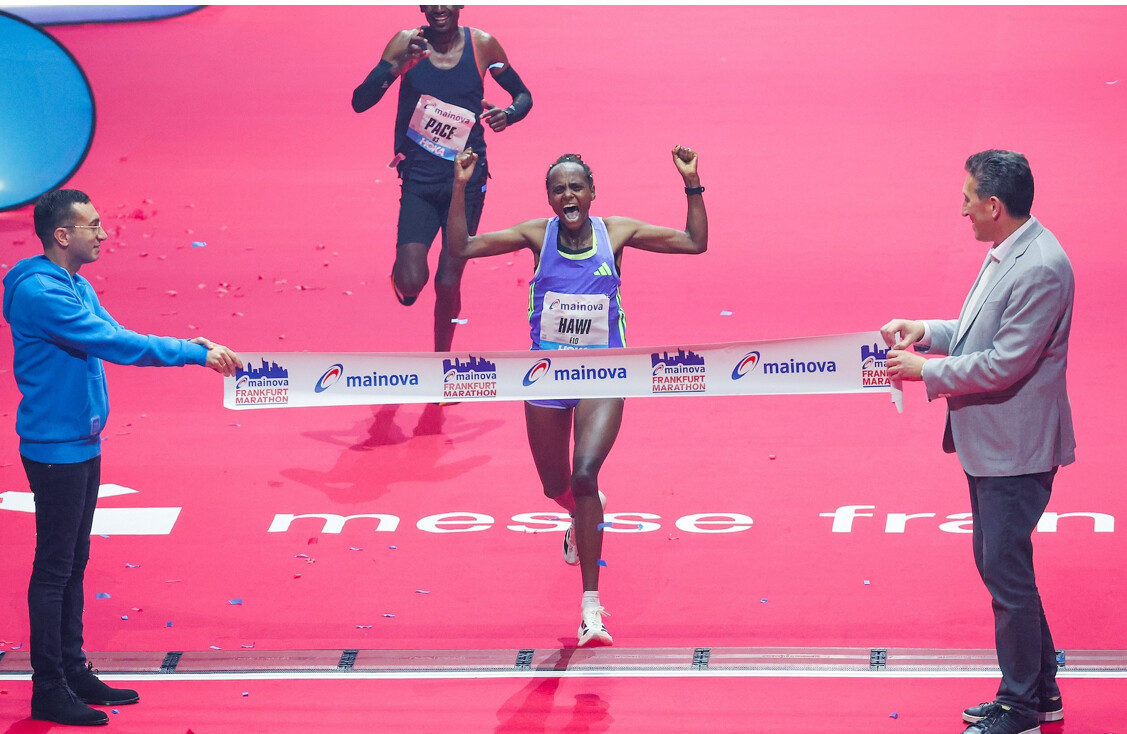
Five women went through halfway in 69:19, among them Hawi Feysa and the two sisters, Magdalyne and Linet Masai from Kenya. When Feysa increased the pace after 25 kilometres, only Magdalyne Masai followed her. Until just before 40 km, Masai was still in contention with the gap a few seconds. But Hawi Feysa proved unbeatable and ran a clearly faster second half of the race to finish in triumph in the Festhalle. Magdalyne Masai was a highly creditable second in 2:18:58.
While it was the first time that two women ran below 2:20 in Frankfurt a large number of elite runners achieved personal bests: Four women from the top 5 and six from the top 10 ran PBs. British runners achieved a string of great results in Frankfurt: Georgina Schwiening was the fastest European with a strong PB of 2:25:46 in eleventh place. A staggering number of seven British women finished inside the top 25 in the „Festhalle“.
Men’s Race: A day for the debutants
The men’s elite field, featuring talent spread evenly throughout, set off at a pace which made the target finishing time of under 2:05 a real possibility. Split times of 29:38 for 10km and 44:30 at 15km pointed to a time in the region of just under 2:05. Subsequently the pace dropped somewhat, despite the excellent weather conditions with temperatures between 12 and 15 degrees, overcast and almost no win. But with a number of kilometre splits around 3 minutes, halfway was reached in 62:52. For much of the time, the 13-strong leading group then stayed compact and there was little change.
The first serious attack came only after 30 km but it proved decisive: Bernard Biwott went to the front and only Gossa Challa proved capable of going with the marathon debutant. But when the Kenyan forced the pace again between 35 and 37 kilometres and covered the single kilometres in around 2:50, the Ethiopian had no reply. Biwott, who previously had shown highly promising form at half marathon, achieving a best of 59:44, won with over a minute and a half to spare. “I’m so happy because I didn’t expect that I could win on my debut. I want to thank the organizers and my manager Gianni Demadonna for their support,” said Bernard Biwott who had achieved a rare win here on debut. The last occasion in the men’s race in Frankfurt was in 2008 when a fellow Kenyan, Robert Cheruiyot, won in what was then a course record of 2:07:21.
To add to the surprises, a marathon debutant was also the fastest runner from Germany in the Mainova Frankfurt Marathon. Jan Lukas Becker finished 17th in 2:15:20 and had been on course for a finishing time of under 2:11 for much of the race.
Results, Men:
1. Benard Biwott KEN 2:05:54
2. Gossa Challe ETH 2:07:35
3. Lencho Tesfaye ETH 2:08:02
4. Gerba Dibaba ETH 2:09:03
5. Aychew Dessie ETH 2:09:22
6. Workneh Serbessa ETH 2:09:30
7. Christopher Muthini KEN 2:09:31
8. Ebba Chala SWE 2:09:35
9. Tim Vincent AUS 2:09:40
10. Mulat Gebeyehu ETH 2:10:07
Women:
1. Hawi Feysa ETH 2:17:25
2. Magdalyne Masai KEN 2:18:58
3. Shuko Genemo ETH 2:22:37
4. Catherine Cherotich KEN 2:22:42
5. Agnes Keino KEN 2:22:53
6. Kidsan Alema ETH 2:23:27
7. Linet Masai KEN 2:23:52
8. Judith Kiyeng KEN 2:24:41
9. Betty Chepkwony KEN 2:25:13
10. Aberash Korsa ETH 2:25:43
(10/27/24) Views: 85Kenya's Elisha Rotich eyes record breaking time at Frankfurt Marathon
Rotich who stands out in the men’s lineup with his exceptional personal best of 2:04:21 is eying a record time finish on the course.
Kenya’s elite marathoners are set for a fierce showdown at the Frankfurt Marathon this Sunday, with seasoned runner Elisha Rotich leading the charge.
Rotich, renowned for his prowess on the marathon circuit, stands out in the men’s lineup with his exceptional personal best of 2:04:21, achieved during his record-breaking win at the 2021 Paris Marathon.
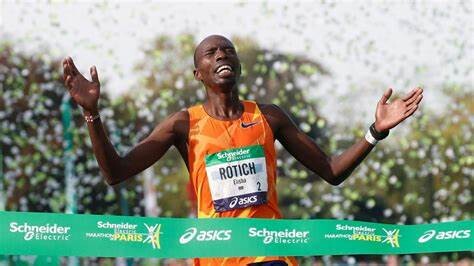
This feat notably saw him surpass the esteemed Kenenisa Bekele’s best time, firmly establishing Rotich as a formidable presence in international marathon running.
Rotich has expressed confidence in his preparations, noting he has spent five intensive months training specifically for the Frankfurt Marathon.
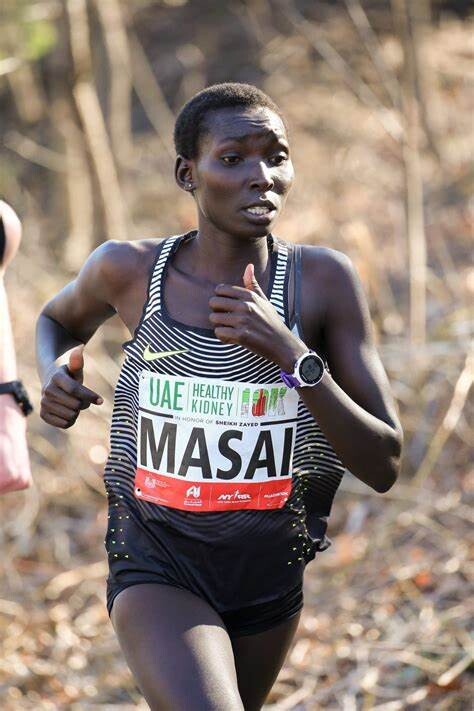
“I’ve rigorously trained for five months targeting the Frankfurt Marathon. Favorable weather, cooler temperatures, and cooperative pacing within the lead group could facilitate sub-2:05 performances,” he shared via Watch Athletics.
Optimistic about favorable weather conditions and strong pacing, Rotich hopes these factors will help him achieve another remarkable sub-2:05 finish.
However, Rotich’s path to the top won’t be without challenge.
He faces tough competition from a talented Ethiopian quartet, including Lencho Tesfaye, who has a personal best of 2:06:18, Aychew Banti (2:06:23), Abay Alemu (2:06:50), and Birhan Nebebew (2:06:52).
Each of these runners has consistently delivered strong performances, underscoring the intense competition that awaits on Sunday.
In addition to Rotich, Kenya is represented by Reuben Kiprop (2:09:06), Bernard Muia (2:09:17), and Vincent Ronoh (2:09:21). T
his group, while less heralded, brings both depth and resilience to Kenya's bid for top honors in Frankfurt.
The women’s field also promises excitement, with Kenya’s Magdalyne Masai leading her country’s contingent with a commendable personal best of 2:22:16.
Masai will face tough competition from Ethiopia’s Shuko Genemo, who has clocked 2:21:35, and Meseret Dinke (2:22:35).
All eyes, however, remain on the 2019 Frankfurt course record of 2:19:10 set by Kenya’s Valary Aiyabei.
With such a strong lineup, the possibility of breaking Aiyabei’s record appears within reach.
(10/26/24) Views: 84Stephen Awino
6 Mistakes You Make When Looking at a Marathon Course Map
Set yourself up for success with tips from professional course measurers and cartography experts.
When you sign up for a race, it’s pretty standard to look at the course map. You may note the obvious points, like the start and finish, key mile markers, elevation, and any interesting monuments or sights along the way. But there’s another layer of helpful information to uncover if you know what to look for. Taking a closer look may even help you score a PR for that half marathon or full 26.2.
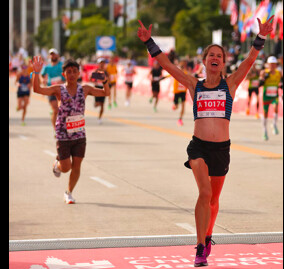
In interviews with professional course measurers and cartography experts, we outlined some mistakes you’re probably making when studying a course map. Here are six ways you can level up your preparation for race day.
You Miss Out on Tangents
You should definitely study the course map well in advance. A course map reveals key information that can give you an edge over the competition, says Neyl Marquez, a USA Track and Field course certifier and World Athletics course measurer.
For example, a course map reveals the tangents to utilize in racing. In cross-country and road races, “running the tangents” refers to covering the shortest possible distance from one point to another. In road racing, this typically means running on the inside curve of the road at all times. It’s also a tactic that can sometimes make or break a PR attempt.
Studying a course map will show you the number of turns and the distance between one turn and the next, Marquez points out. This can help you to plan which side of the road you should run to efficiently navigate the following turn and avoid running longer than necessary. For example, if you know there will be a series of hard turns on a road 5K that go left, right, left, you’ll want to make your way toward the following side or at least the middle of the road heading into the next turn. “It makes a difference at what point you decide to start running toward that next available turn, and that’s knowing the course,” Marquez says.
You Overlook the Shape of the Course
Studying a course map will help you visualize the type of race
It’s also important to plan for the 90-degree turns, so you can run them efficiently and not expend too much unnecessary energy. “[For right angle turns] you want to take the turn wide because you can maybe maintain your stride efficiency,” he says. “If you take the turns tight, you’re going to have to slow down at the turn and then accelerate out.”
You Skim Over the Terrain
Race organizers of hillier courses will include an elevation profile along with the course map, and it’s key to examine the topography before race day. For some races with notorious hills, i.e. the Boston Marathon and New York City Marathon, it’s critical to incorporate specific hill grades into your training.
Knowing where to expect the inclines and declines is also helpful when determining how to strategize effort during the race, Hartnett says. He created the elevation profile for the New York City Marathon, which includes bridge ascents and various uphills throughout the city, but the course also features several flat and downhill sections runners should take advantage of, he notes.
You Don’t Examine the Aid Stations
Most course maps indicate where the aid stations are located on the course, which is
(10/27/24) Views: 82




